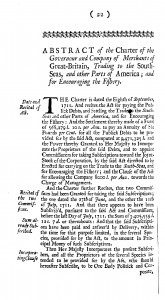This project features a variety of charters, each of which has its own unique set of characteristics that help to trace the evolving British ideas of sovereignty.
The earliest charters covered by our project are those of Newfoundland and Maine (written in 1629). With these charters the problems of early exploration become especially apparent. The Maine charters are grants of small tracts of lands to individual landowners that represent the transition between the expansive claims of royal charters and the more practical divisions of land for settlement. Newfoundland’s charter foreshadows the massive and unrealistic claims that would come later on during the colonial era: its original boundaries extend far off the coast of the island in order to protect fishing rights and to claim acreage on the mainland.
The next charter chronologically is the Connecticut Charter of 1662, one that exemplifies the competitive nature of charters during the first age of colonization. However, instead of competing with land grants and charters from foreign nations, Connecticut faced competition from its fellow English colonies, each struggling for dominance in the New England area. Boundary disputes between Connecticut, Rhode Island, and the surrounding colonies occurred frequently in the 18th century. As these provinces changed into states after the American Revolution the disputes remained the same; this conflict over boundaries exists to this day.
This idea of owning the sea becomes very prevalent in another of the charters, that of the South Seas Company. In 1711, this charter gave the aforementioned company rights to trade in a vast segment of water generally labeled as the “South Sea”. Where this body of water existed and the waters trading company differed greatly; this lead to financial conflict and eventually caused an economic bubble to form which, once it burst spelled doom for the company.
Finally, the charter of Georgia represents something unique in this collection. It comes after the major age of North American colonial establishment, for its main purpose was not to create new sovereignty but to instead protect the sovereignty of those living in the unstable southern area of the Carolina colony. The founders of Georgia were not proprietors but trustees charged with taking humanitarian action in helping those under their jurisdiction. However, as the colony grew stronger and the threat of Spain grew weaker (especially after the cession of Spanish Florida in 1763), Georgia became a threat to the sovereignty of all the colonies around it, and was only limited by treaties in that year.






